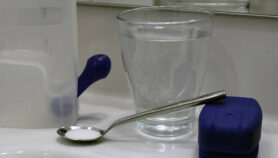By: Ochieng’ Ogodo
Send to a friend
The details you provide on this page will not be used to send unsolicited email, and will not be sold to a 3rd party. See privacy policy.
Using a condom in conjunction with a diaphragm — a latex contraceptive cap that fits tightly over a woman’s cervix — to protect against HIV infection in women is no more effective than relying on a condom alone.
The findings are reported in an article published this week in The Lancet (13 July) by Nancy Padian, from the University of California in San Francisco, and her colleagues. The team, from Methods for Improving Reproductive Health in Africa (MIRA), did a randomised trial of almost 5,000 sexually active, HIV-negative women in South Africa and Zimbabwe.
“Although the intervention seemed safe, our findings do not support addition of the diaphragm to current HIV-prevention strategies,” they conclude.
But Gita Ramjee, director of the HIV Prevention Research Unit of the Medical Research Council of South Africa, told SciDev.Net that the study was very important to establish whether covering the cervix with a diaphragm could reduce the risk of HIV infection.
“We are desperately looking for something that is under women’s control (and diaphragm use is) to see if it reduces the risk. The result of the study does not mean the end of women-initiated research, as we need to continue to find more efficacious products.”
The researchers compared the provision of a diaphragm, lubricant gel and a condom to half the women (intervention group) with provision of a condom alone to the remainder (control group). The women were tested quarterly for HIV for 12–24 months (median, 21 months).
In addition, all the women were given an ‘HIV-prevention package’ of pre-test and post-test counselling about HIV and sexually transmitted infections, testing, treatment of curable sexually transmitted diseases, and intensive risk-reduction counselling.
The researchers found that HIV incidence in the two groups was not significantly different. The intervention (diaphragm) group had an HIV incidence of 4.1 per cent over the follow-up period, compared with 3.9 per cent in the control group. According to the researchers, this means that there is no extra protective benefit against HIV infection when a diaphragm and lubricant gel are used in addition to a condom.
The authors note that the proportion of women using condoms was significantly lower in the diaphragm group than in the control group (54 per cent as opposed to 85 per cent), possibly because of a perceived irrelevance of a second barrier method.
According to Ramjee, diaphragms cannot be recommended for HIV prevention on the basis of the results of this trial, and research has to continue.
She said that research is ongoing into microbicide vaginal gels for prevention of infection by HIV. “Maybe in the future we can test microbicides with a diaphragm to see whether the protection against HIV is better,” she suggests.
Link to full paper in The Lancet*
Reference: The Lancet doi 10.1016/S0140-6736(07)60950-7*Free registration is required to view this article.













